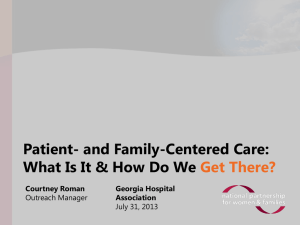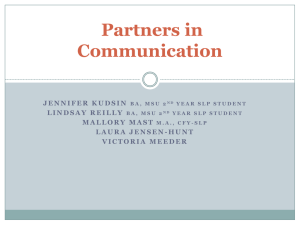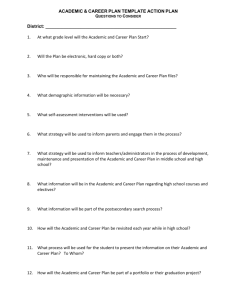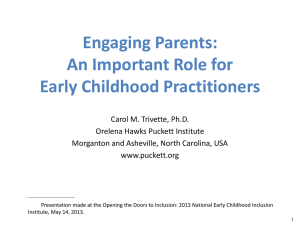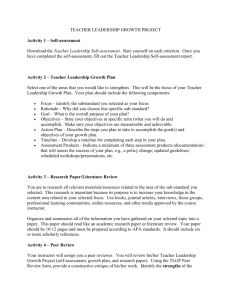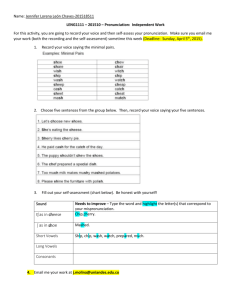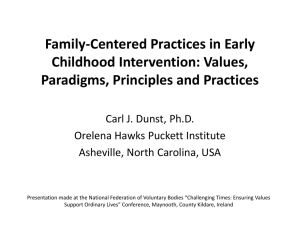family-centered care self-assessment tool
advertisement
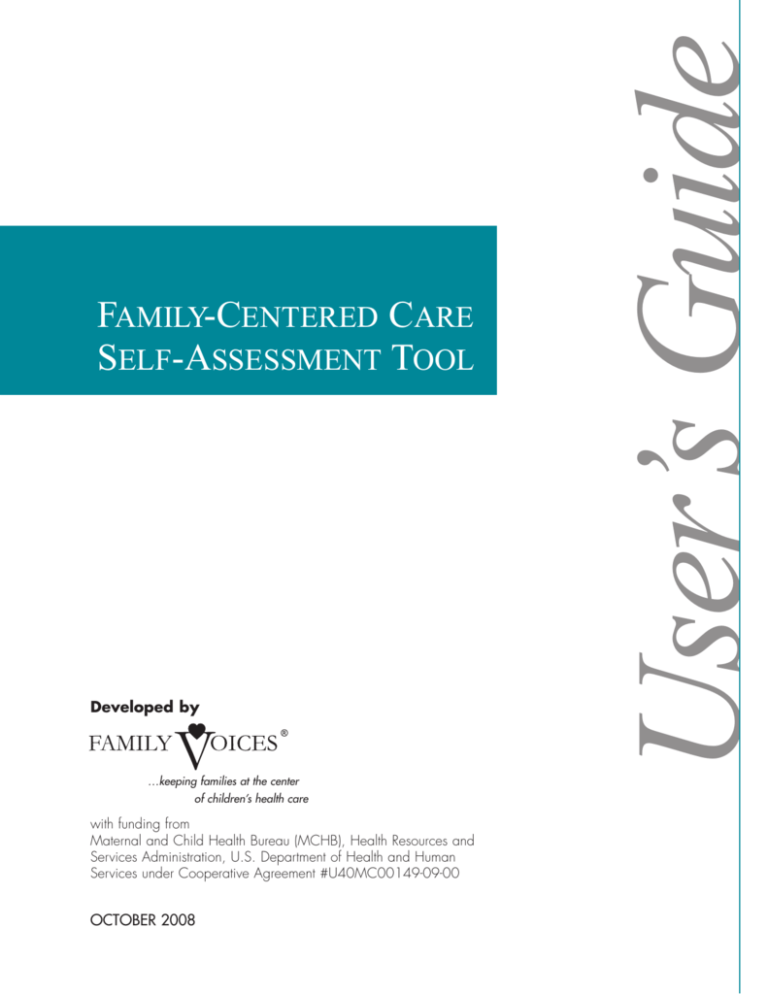
Developed by …keeping families at the center of children’s health care with funding from Maternal and Child Health Bureau (MCHB), Health Resources and Services Administration, U.S. Department of Health and Human Services under Cooperative Agreement #U40MC00149-09-00 OCTOBER 2008 User’s Guide FAMILY-CENTERED CARE SELF-ASSESSMENT TOOL ACKNOWLEDGEMENTS The Family-Centered Care (FCC) Self-Assessment Indicator Tool would not have been possible without the visionary guidance of Diana Denboba, Merle McPherson, and Bonnie Strickland, past and present leaders of the Maternal and Child Health Bureau, Division of Services for Children with Special Health Care Needs. We acknowledge and appreciate the assistance that the American Academy of Pediatrics (AAP) has extended to this project by hosting some of the meetings in Washington D.C. as well as providing financial assistance for the dissemination of the FCC Indicator Tool. Special thanks to the families and professionals who worked with Family Voices to shape and develop this publication through in-person meetings, conference calls, and countless reviews. These include: John Arango, Polly Arango, Wendy Benz, Kathleen Kirk Bishop, Christy Blakely, Suzanne Bronheim, Jennifer Cernoch, Carl Cooley, Nancy DiVenere, Monique Fountain-Hanna, Patti Hackett, Wendy Jones, Karen Kuhlthau, Lauri Levin, Jennifer Marks, Deanna McPherson, Jen Powell, Phyllis Sloyer, Fan Tait, Connie Wells, Nora Wells, and Josie Woll. In addition, we thank the family leaders who attended a focus group in Washington, D.C. during the Family Voices National Conference in May 2007, and the Family-Centered Care meeting in June 2008. The final publication was prepared by Suzanne Bronheim, Christy Blakely, and Beth Dworetzky under the direction of Sophie Arao-Nguyen. 1 Family-Centered Care Self-Assessment Tool: User’s Guide DEFINITIONS OF TERMS Alternative Healing is the use of herbs, aromatherapy, acupuncture, massage and other remedies that are not considered part of conventional (Western) healthcare treatments. http://www.aap.org/healthtopics/complementarymedicine.cfm is the physical location where a family and child/youth receives outpatient health services. These services can be provided by a pediatrician, other physician, physician’s assistant, nurse, social worker, care coordinator, or any other staff person at this setting. Care Setting have or are at increased risk for chronic physical, developmental, behavioral, or emotional conditions that require health and related services of a type or amount beyond that required by children generally. Children and Youth with Special Health Care Needs McPherson M, Arango P, Fox H, Lauver C, McManus M, Newacheck P, Perrin J, Shonkoff J, Strickland B. A new definition of children with special health care needs. Pediatrics, 102(1):137-140, 1998. are local, non-medical services that help children and families accomplish daily activities. These services can range from school, childcare, after-school activities, family and peer support and advocacy groups, early intervention or Head Start (a program that helps families learn about and promote the development of their young children). Community-based Services is approval for healthcare decisions. Individual must have legal authority to provide consent. Generally, the parents or legal guardians of minor children (younger than 18 years old) provide consent. For individuals 18 and older who cannot make their own decisions, a legal guardian or proxy can provide consent. Consent requires organizations to have a defined set of values and principles and demonstrate behaviors, attitudes, policies and structures that enable them to work effectively cross-culturally. They should: • Value diversity, • Conduct self-assessment, • Manage the dynamics of difference, • Acquire and institutionalize cultural knowledge and • Adapt to diversity and the cultural contexts of the communities they serve. Cultural Competence Organizations should incorporate the above in all aspects of policymaking, administration, practice, service delivery and involve systematically consumers, key stakeholders and communities. Cultural competence is a developmental process that evolves over an extended period. Both individuals and organizations are at various levels of awareness, knowledge and skills along the cultural competence continuum. (Adapted from Cross et al., 1989) http://www11.georgetown.edu/research/gucchd/nccc/foundations/frameworks.html 2 Family-Centered Care Self-Assessment Tool: User’s Guide Family—Families are big, small, extended, nuclear, multi-generational, with one parent, two parents, and grandparents. We live under one roof or many. A family can be as temporary as a few weeks, as permanent as forever. We become part of a family by birth, adoption, marriage, or from a desire for mutual support. As family members, we nurture, protect, and influence each other. Families are dynamic and are cultures unto themselves, with different values and unique ways of realizing dreams. Together, our families become the source of our rich cultural heritage and spiritual diversity. Each family has strengths and qualities that flow from individual members and from the family as a unit. Our families create neighborhoods, communities, states, and nations. Developed and adopted by the New Mexico Legislative Young Children’s Continuum and New Mexico Coalition for Children, June 1990. are services that strengthen and support the family’s role as caregiver and decision-maker on behalf of their children. Family Supports are ways to bring together families, youth and others who share similar life situations so they can share their knowledge, concerns, and experiences with each other. Family-to-Family and Peer Supports HIPAA (The Health Insurance Portability and Accountability Act). This is a federal law that protects the privacy of personal health information. You must give permission before personal health information can be shared with: • Health providers, • Hospitals, • Insurance companies, state and federal agencies, • Schools, • Employers, or • Anyone else. You also have the right to read your medical record and make corrections. For more information visit: http://www.hhs.gov/ocr/hipaa is the capacity of an organization and its personnel to communicate effectively, and convey information in a manner that is easily understood by diverse audiences including persons of limited English proficiency, those who have low literacy skills or are not literate, and individuals with disabilities. Linguistic competency requires organizational and provider capacity to respond effectively to the health literacy needs of populations served. The organization must have policy, structures, practices, procedures and dedicated resources to support this capacity. Linguistic Competence Goode & Jones (modified 2004). National Center for Cultural Competence, Georgetown University Center for Child & Human Development. http://www11.georgetown.edu/research/gucchd/nccc/foundations/frameworks.html. Provider—in the context of this tool is any person that provides services within the care setting. Transition to Adulthood—The period of time during which families, youth and providers plan for and develop the process to assure that youth will: 1. Be able to successfully manage all aspects of their healthcare and be prepared to take on adult responsibilities, and ultimately, live as independently as possible and 2. Continue to receive high quality healthcare services. 3 Family-Centered Care Self-Assessment Tool: User’s Guide INTRODUCTION Health care visits for children, youth and their families can be more than getting shots, having ears examined or treating the physical symptoms of an illness. Each visit is an opportunity for families, youth and health care providers to partner to assure quality health care for the child and to support the family’s needs in raising their child. This enhanced aspect of the family and health care provider relationship is called family-centered care. The foundation of family-centered care is the partnership between families and professionals. Key to this partnership are the following: • Families and professionals work together in the best interest of the child and the family. • As the child grows, s/he assumes a partnership role. • There is mutual respect for the skills and expertise each partner brings to the relationship. • Trust is fundamental. • Communication and information sharing are open and objective. • Participants make decisions together. • There is a willingness to negotiate. Within that framework, ten components of family-centered care have been identified. (National Center for Family-Centered Care (1989); Bishop, Woll and Arango (1993)) Family-centered care accomplishes the following: 1. 2. 3. 4. 5. 6. 7. 8. 9. Acknowledges the family as the constant in a child’s life. Builds on family strengths. Supports the child in learning about and participating in his/her care and decision-making. Honors cultural diversity and family traditions. Recognizes the importance of community-based services. Promotes an individual and developmental approach. Encourages family-to-family and peer support. Supports youth as they transition to adulthood. Develops policies, practices, and systems that are family-friendly and family-centered in all settings. 10. Celebrates successes. P U R P O S E O F T H E FA M I LY- C E N T E R E D C A R E SELF-ASSESSMENT TOOL Family-centered care is a key aspect of quality in health care for children, youth and their families. This tool is designed to: 1. Increase outpatient health care settings’ and families’ awareness about the implementation of family-centered care and, 2. Provide an organized way for health care settings to assess current areas of strength and identify areas for growth, plan future efforts and to track progress. This tool is not designed to provide a score but is meant as an opportunity for reflection and quality improvement activities related to family-centered care within outpatient health care practices. It can also be used by families to assess their own skills and strengths, the care their 4 Family-Centered Care Self-Assessment Tool: User’s Guide children and youth receive, and to engage in discussions within health care settings and with policy makers in organizations, health plans and community and state agencies about ways to improve health care services and supports. The tool is intended to assess care for all children and youth and also has some questions that are specific to the needs of children and youth with special health care needs and their families. Questions on the tool address the ten components of family-centered care and the key aspects of family/youth/provider partnerships. D E S C R I P T I O N O F T H E FA M I LY- C E N T E R E D C A R E SELF-ASSESSMENT TOOL The tool is divided into three major sections: 1) Family/Provider Partnership, 2) Care Setting Practices and Policies and 3) Community Systems of Services and Supports. Within each major section, there are several subtopics that address family-centered care. Sections and Subtopics of the Family-Centered Care Self-Assessment Tool Family/Provider Partnership • The decision-making team • Supporting the family as the constant in the child’s life • Family-to-family and peer support • Supporting transition to adulthood • Sharing successes Care Setting Practices and Policies • Giving a diagnosis • Ongoing care and support • Addressing child/youth development • Access to records • Appointment schedules • Feedback on care setting practices • Care setting policies to support family-centered care • Addressing culture and language in care Community Systems of Services and Supports • Information and referral and community-based services • Community systems integration and care coordination Each section contains a series of questions that ask about concrete actions that reflect familycentered care. Each section is coded with numbers that indicate which of the ten elements of family-centered care it addresses. 5 Family-Centered Care Self-Assessment Tool: User’s Guide BENEFITS OF USING THE TOOL Families, both individually and within family support and advocacy organizations, can use the tool to increase awareness and knowledge of the specifics of family-centered care to more effectively: • Assess the quality of the care that they and their children receive; • Share knowledge about family-centered care with other families, with providers, with health plans and with policy makers to create a shared vision for improving the health care system; • Advocate for changes within health care settings, health plans and public agencies to more effectively support families and their children in the process of receiving care. Health care settings can use this structured tool in quality improvement activities and to support development of the first key component of a medical home as defined by the American Academy of Pediatrics—“provision of family-centered care through developing a trusting partnership with families, respecting their diversity, and recognizing that they are the constant in a child’s life.” (AAP, 2002) The tool can be used to increase family satisfaction with the care setting and to increase its standing in the community. can use the tool to support quality improvement of the practices within their provider panels. Health plans Policy-makers at community, state and federal levels will be able to gain knowledge about current practices within the provider community and to develop awareness and knowledge that will support policies to promote and sustain family-centered care and to allocate resources to support health care settings in providing family-centered care. HOW TO USE THIS TOOL The Family-Centered Care Self-Assessment Tool can be utilized in a number of ways. It was designed to be used by care settings in partnership with the families and youth they serve to review current practices and policies and to determine the settings’ strengths and areas for growth related to family-centered care. This next section will provide a detailed set of steps to use the tool for a full assessment of a practice setting. In addition, the tool may be used as an educational tool to build awareness and knowledge of family-centered care for families, youth, providers, health plans and policy-makers. The items of the tool may also be used in defining family-centered care for policies, contracts and quality standards and can be used to compare a family-centered approach with other care models. Utilizing the Family-Centered Care Self-Assessment Tool in a Health Care Practice Setting The tool is currently designed for use in outpatient care settings. As noted, it is designed to assess care received by all children and youth and their families and includes some questions that may apply primarily to children and youth with special health care needs. This section provides guidelines for ensuring the success of the self-assessment process. Creating a Safe and Supportive Assessment Environment The self-assessment process works most effectively if everyone—families, youth, providers, care setting staff—understand why and how the assessment will be conducted. Looking at one’s practice setting or assessing one’s health care providers can sometimes make all concerned feel somewhat vulnerable. It is therefore important to prepare everyone for the process and to create a process that 6 Family-Centered Care Self-Assessment Tool: User’s Guide feels safe for providers, staff, families and youth. Some key considerations in creating a safe and supportive environment for self-assessment include: • Discussing the purpose of the self-assessment with all providers and staff—emphasize the goal of quality improvement and identifying strengths, not “grading” the practice or individuals in it; • Creating a process that assures confidentiality—assure families and staff that their feedback on the tool will not be linked to them. (In very small practice settings, staff/provider confidentiality may be difficult to maintain, and each practice will need to discuss this issue and determine ways for those providing feedback to feel safe.) • Utilizing safeguards like those used to protect human subjects in a research activity—families and youth should be given an option to not participate and be assured that this will not affect their care; confidentiality should be assured and described, assuring families that the input they give will not affect their access to services; if youth are not old enough to give consent, families should give consent for their participation and youth should give assent; the completed tools and the data should be kept in a way to assure confidentiality; etc. • The current version of this tool is not available in languages other than English nor is it suited for those with low or no literacy skills. Special consideration will be needed to allow the full range of families in a care setting to participate and to assure that they feel safe in doing so. Families may need support in completing the tool by having it read to them or having an interpreter work with them in another language. It is vital that those providing this extra support not be viewed as part of the care setting staff or providers to assure confidentiality. Care settings may consider partnering with community/state family support organizations or community-based ethnic/language specific organizations as partners to provide this type of support. Steps for Implementing a Family-Centered Care Self-Assessment Process The following steps are suggested to implement a successful process for gaining information from this tool that will support improvements in family-centered care. STEP 1. Develop a structured plan for how the tool will be used. It is important to spend time before using to tool to define the why and how of the self-assessment process. This first phase should include the following actions: • Identify a care-setting self-assessment team. This team should include providers and clinical staff, front-desk/non-clinical staff in the setting and families/youth served in the care setting. If the practice has some formal family/youth advisory body, then that group would be a key partner in the process. If no such group exists, the care setting could recruit family/youth partners from within the practice. Families will need supports to participate in the process, which may include stipends for expenses, pay for time and expertise, training and mentoring, and supports related to literacy and language. Family advocacy support organizations within the community and state (such as the Family-to-Family Health Information Centers) can help identify and mentor families for the process. Find the contact information for the Family-to-Family Health Information Center is your state at www.familyvoices.org/projects/f2f.php. • Define the scope of the self-assessment process. How many families will be invited to be part of the assessment? Will all families be asked for input, or is there a particular segment of the practice that will be the focus (e.g., families of young children, families with grandparents caring for children, etc.)? If the care setting has multiple functions or clinics, will the assessment focus on only one or on the entire organization? 7 Family-Centered Care Self-Assessment Tool: User’s Guide • Define the questions to be answered by the self-assessment process. Potential questions might include: – What strengths do we have that we can build on? – What are our areas of greatest challenge? – How can our areas of strength help us improve in areas that we are challenged? – What are areas where we are “almost there” and could quickly have success? – Are there policies in place that could support improvements to family-centered care? If so, are staff and families aware of those policies? – Are there particular types of families with whom we partner particularly well? With whom we need to expand our partnerships? – Do providers/staff and families/youth have a similar view of family-centered care in our setting? – What areas should we prioritize for change? • Determine what resources will be needed to successfully complete the self-assessment. Potential resources include: – Time of staff person to coordinate the process; – Funds for mailing and time for follow-up phone calls; – Supports for families with language and literacy issues to participate; or – Time of staff or consultant to tabulate scores and help interpret and report the findings. • Identify the lead person(s) who will coordinate the process. This coordination process will include the following: – Recruiting participants; – Distributing and collecting the tools; – Follow-up to assure a good response rate; – Organization of completed tools for analysis; and – Assuring that the timeline is followed. • Create a timeline for the self-assessment process. The timeline might include: – Informing others about the process and purpose of using the tool – Deadlines for dissemination and collection of tool – Deadlines for scoring and reporting findings • Develop an information sharing plan which includes: – When; – With whom; and – Formats appropriate to each audience (including families with needs for alternate formats or languages). STEP 2. • • • • • 8 Implementing the assessment Prepare providers, staff and families for the process—create enthusiasm for the process and emphasize the positive potential outcomes. Talk about how the self-assessment process meshes with the vision, mission, and values of the care setting. Inform providers, staff and families about the timeline and procedures. Disseminate the tool and collect the completed forms. Follow-up to assure adequate participation. Inform participants about how and when they will receive information about the outcome of the self-assessment. Family-Centered Care Self-Assessment Tool: User’s Guide STEP 3. Scoring the tool. Create a paper or electronic spreadsheet or a form on a computer statistical software package to record the scores on each item for each person completing the FCC Self-Assessment Tool. Since the Provider and Family versions of the tool are not identical, two such recording formats will be needed. Set the recording sheet up so that the frequency of each response for each question and each subsection can be calculated. If your practice setting is interested in analyzing differences among sub-groups of families, develop a coding process that will allow you to sort the respondents by type for your analysis. 1. After entering the data from all of the completed questionnaires, calculate the number of each type of response for each question. Next, calculate percentages for each response. It may be useful to total the number for each response across an entire subsection as well. This will provide an overview of broad areas of strength or areas of growth for your care setting. 2. Choose criteria for a definition of areas of strength and areas of growth for your care setting. For example, it is recommended that items on which at least 75% of those responding to the tool indicated that the action occurred “Always” might be chosen as strengths. Items on which a combined 75% chose “Most of the time” or “Always” could be seen as relative strengths and opportunities for immediate improvement. Items that were rated “Always” and/or “Most of the time” by less than 75% of those taking the tool could be considered areas for growth. Note: The current version of this tool has not undergone validation studies to determine its psychometric properties. Thus, using the Likert scale points as numerical scores is not recommended. Information from the tool should be reported as frequencies/percentages, not as mean scores. STEP 4. Analyzing and reporting information. After you have completed the scoring, utilize the self-assessment team to plan the process to analyze the findings. You may want to have a staff member or consultant prepare a preliminary report on areas of strengths and areas for growth in the care setting for this group to discuss. Use the information gained from the tool to answer the questions you developed during the planning phase. Determine goals for change and improvement based on the information you have. Sharing the information from the assessment with families, youth, providers and staff is essential. Create a way to share the information that highlights strengths, indicates areas and priorities for change and does not threaten or blame individuals or groups within the setting for areas of growth. Reports may be: written and verbal; shared via meetings or group sessions; disseminated in care setting brochures, newsletters, websites, etc. Consider alternative formats and languages for reporting so that all families in the care setting have access to the information. Consider holding debriefing sessions or focus groups with families and providers/staff to discuss the findings and gain a deeper understanding of factors that might support change and improvement. 9 Family-Centered Care Self-Assessment Tool: User’s Guide STEP 5. Developing a plan for change and improvement. Using the information from the assessment process, the care setting can then develop priorities, actions and timelines to make the changes and improvements desired based on the initial assessment purpose and goals. In keeping with the concept of family/youth/provider/staff partnerships, action plans should include participation from all these groups—all should be involved in defining priorities and defining what successful change will look like. While a setting may develop a broad plan for improvements with timelines and processes, experience suggests that specific changes occur when made in small concrete, testable steps. In many states, supported by grants from the federal Maternal and Child Health Bureau, Health Resources and Services Administration, US Department of Health and Human Services, partnerships to create a medical home for all children and youth have been undertaken. Within many of these efforts, learning collaboratives have taught care settings how to use a methodology for change called Plan-Do-Study-Act (PDSA). (Langley, Nolan, Nolan and Norman, 1996) The Family-Centered Care Self-Assessment Tool can be used in that or other change and improvement processes in several ways including: • Identifying areas for change; • Raising questions to be addressed in the change process; • Providing baseline data to measure change; • Providing data to measure predicted outcomes of the change process. Individual items or subsections can be used to address very specific changes tested. Self-assessment and quality improvement are on-going activities. Action plans should set out timelines for reassessing the care setting and roles and responsibilities for members of the team in supporting change. AFTER USING THE TOOL Family Voices welcomes your feedback about this tool. Please visit the website at www.familyvoices.org and complete a short survey. We will use your comments, ideas and suggestions to improve future versions. RESOURCES Youth Resources The American Medical Association has resources for promoting adolescent health at http://www.ama-assn.org/ama/pub/category/1947.html Healthy and Ready to Work National Resource Center (HRTW) focuses on understanding systems, access to quality health care, and increasing the involvement of youth. The website provides one-stop shopping for information about transition to adult life. There are easy-tounderstand descriptions of federal initiatives and government benefits, information created by youth for youth, tools, information about laws and access to health care checklists and many other resources. For more information go to www.hrtw.org. 10 Family-Centered Care Self-Assessment Tool: User’s Guide KASA—Kids As Self Advocates—is a national, grassroots project created by youth with disabilities for youth. They provide information and support to others so they can make choices and advocate for themselves. Naomi Ortiz, Project Director ortizn@fvkasa.org (785) 273-3398 www.fvkasa.org Family Voices, Inc. 2340 Alamo SE, Suite 102 Albuquerque, NM 87106 Attn: KASA Project Families with Children and Youth with Special Health Needs Resources are parent-run centers where families with children and youth with special health needs and others can get information to help them navigate health care financing issues and other services and supports so they can make informed decisions about services for their children and develop effective partnerships with their children’s providers. Find the Family-to-Family Health Information Center in your state at http://www.familyvoices.org/projects/f2f.php. Family-to-Family Health Information Centers Family Voices is a national, grassroots organization of families with children and youth with special health needs, our professional partners and friends. Their goal is to achieve family-centered care for all children and youth with special health care needs and/or disabilities. Through their national network, they provide information and tools to families so they can make informed decisions about their children’s health care needs, advocate for improved public and private policies, build partnerships among professionals and families, and serve as a trusted resource on health care. Visit the website to find the Family Voices network member in your state. Family Voices, Inc. 2340 Alamo SE, Suite 102 Albuquerque, NM 87106 (505) 872-4774 or (888) 835-5669 Email: kidshealth@familyvoices.org http://www.familyvoices.org Parent to Parent programs provide emotional and informational support to families of children who have special needs by matching parents seeking support with an experienced, support parent. Find the Parent-to-Parent support program in your state at http://www.p2pusa.org. 11 Family-Centered Care Self-Assessment Tool: User’s Guide Provider Resources provides national leadership and contributes to the body of knowledge on cultural and linguistic competency within systems and organizations. Major emphasis is placed on translating evidence into policy and practice for programs and personnel concerned with health and mental health care delivery, administration, education and advocacy. Visit the website to read promising practices, publications, access resource databases and more. The National Center for Cultural Competence National Center for Cultural Competence Georgetown University Center for Child & Human Development Box 571485 Washington, DC 20057-1485 Voice: (202) 687-5387 or (800) 788-2066 Fax: (202) 687-8899 E-mail: cultural@georgetown.edu http://gucchd.georgetown.edu/nccc The National Center of Medical Home Initiatives for Children with Special Needs provides support to physicians, families, and other medical and non-medical providers who care for children with special needs so that they have access to a medical home. Learn about the elements of familycentered care, read about medical home initiatives in each state, and explore the resources for families, youth, providers, insurers, and communities. The National Center of Medical Home Initiatives 141 Northwest Point Blvd Elk Grove Village, IL 60007 Voice: (847) 434-4000 Fax: (847) 434-4000 E-mail: medical_home@aap.org http://www.medicalhomeinfo.org General Resources is a clearinghouse for information about maternal and child health resources. In addition to databases, resource guides, and weekly alerts, the MCH library has created a set of knowledge paths. These paths are “road maps” with up-to-date, reliable information, for families and professionals. In particular, the Community Services Locator: Locating Community-Based Services to Support Children and Families knowledge path at www.mchlibrary.info/KnowledgePaths/kp_community.html is a collection of information that links families to the services, supports and resources available in the community where they live. www.mchlibrary.info or www.mchlibrary.info/nonenglish.html for non-English materials and resources. The Maternal and Child Health Library (MCH) The National Center for Family/Professional Partnerships has resource materials for building family/provider partnerships to promote families as partners in decision-making at all levels and satisfaction with the services they receive. Family Voices, Inc. 2340 Alamo SE, Suite 102 Albuquerque, NM 87106 (505) 872-4774 or (888) 835-5669 Email: nwells@familyvoices.org http://www.familyvoices.org/info/ncfpp/index.php 12 Family-Centered Care Self-Assessment Tool: User’s Guide REFERENCES American Academy of Pediatrics (2002). Policy statement: the Medical Home, Pediatrics, 110:1, pp. 184-186. Bishop, K., Woll, J. and Arango, P. (1993). Family/Professional Collaboration for Children with Special Health Care Needs and their Families. Burlington, VT: University of Vermont, Department of Social Work. Bishop, K., Woll, J. and Arango, P. (2002-2004). Family-Centered Care Projects 1 and 2. Algodones, NM: Algodones Associates. Langley, G., Nolan, K., Nolan, T., and Norman, C. (1996). Associates in Process Improvement. The Improvement Guide: a Practical Approach to Enhancing Organizational Performance. New York, NY: Jossey-Bass. National Center for Family-Centered Care. Family-Centered Care for Children with Special Health Care Needs. (1989). Bethesda, MD: Association for the Care of Children’s Health. Suggested Citation Family Voices, Inc.(2008) Guide to Using the Family-Centered Care Self-Assessment Tool. Author: Albuquerque, NM. 13
